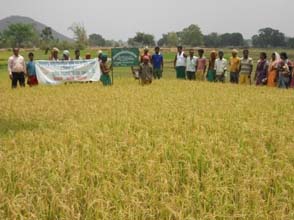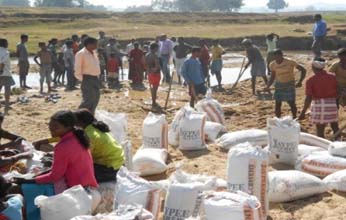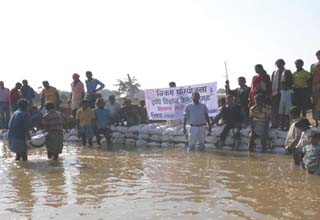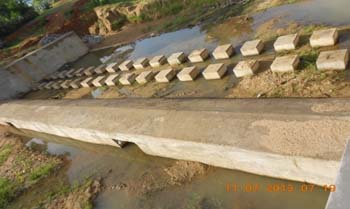 Gunia is a small village in Gumla district of Jharkhand. The village is dominated by tribal population having agriculture their main livelihood. Earlier, the village did not have any source of irrigation except three nearly defunct ponds and cultivation of crops was restricted to wheat for 5-7 hectare, vegetables for 2-3 hectare and sugarcane for only 0.5-1 hectare. Hence, agriculture was totally rainfed and mono-cropped in nature and production was far below the required quantity. However, abundant natural resource in the form of a rivulet, Mahsaria (perennial in nature), flows across the village but utilization of river water for irrigation purpose was never given a comprehensive thought.
Gunia is a small village in Gumla district of Jharkhand. The village is dominated by tribal population having agriculture their main livelihood. Earlier, the village did not have any source of irrigation except three nearly defunct ponds and cultivation of crops was restricted to wheat for 5-7 hectare, vegetables for 2-3 hectare and sugarcane for only 0.5-1 hectare. Hence, agriculture was totally rainfed and mono-cropped in nature and production was far below the required quantity. However, abundant natural resource in the form of a rivulet, Mahsaria (perennial in nature), flows across the village but utilization of river water for irrigation purpose was never given a comprehensive thought.
Implementation of NICRA
In implementing the NICRA project in Gunia village (affected by severe and regular drought), KVK, Gumla critically assessed the available resources to develop a workable plan of action towards improving agricultural situation of the village. Apart from human resources, the KVK also identified the abundant flow of river water which later became the prime source of development. Detailed and frequent interaction with the villagers finally convinced them to offer free labour (Shram Daan) in constructing check dam on the river to impound water with sand bags. It was also decided to partially arrest the river water at the end of monsoon by making sand bag check dam in the rivulet. Voluntary participation of 350 villagers was ensured for two days to build a sand-bag check dam for impounding river water at a minimal cost. The temporary sand-bag check dam helped in impounding large quality of water for its use during post-kharif and entire rabi season.



Unique method of constructing temporary check dam across the river with sand bags created opportunity to take up agricultural activities in Gunia village with renewed vigour. Besides, water table in the village has risen by 44% followed by area expansion under off-season vegetable cultivation in 10.0 hectare, summer paddy cultivation in 10.0 hectare, wheat cultivation in 50.0 hectare and safe harvesting of standing paddy in 30.0 hectare during acute scarcity of rainwater.
Inspiration for Neighboring Villages
The success did not confine only in Gunia village, farmers of adjoining villages and janpratinidhi extended their support in constructing such bora bandi in eight different places on the same river. The cumulative efforts resulted in large production of wheat crop in 125 acres of land beyond the imagination. The paramount success has attracted farmers, NGOs, elected members and administrators to find out efficient management and conservation of water in a mutually benefitting way. Initiative has been taken by Minor Irrigation Department of Jharkhand for constructing series of pucca check dam at the cost of Rs.3.94 crore to arrest water on a perennial basis for irrigation purpose round the year. Deputy Commissioner, Gumla district sanctioned a sum of Rs. 89.0 lakh for implementing ‘Micro Economic Socio Organization Project’ in the adjacent Dumri block to develop second model of check dam with help of KVK.
Apart from ensuring round the year irrigation availability, expanding cultivable area and enhancing cropping intensity, construction of sand-bag check dam has also created an example of convergence among all the stakeholders to take up development issue in the form of joint venture. The tribal community in particular has been immensely benefitted out of this effort.
(Source: Zonal Project Directorate, Zone-II, Kolkata)







फेसबुक पर लाइक करें
यूट्यूब पर सदस्यता लें
X पर फॉलो करना X
इंस्टाग्राम पर लाइक करें